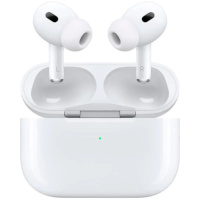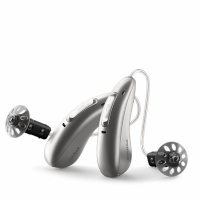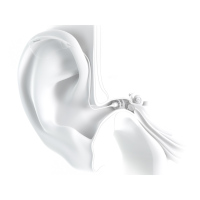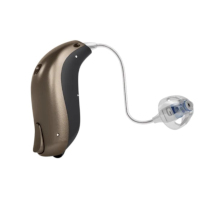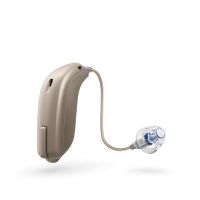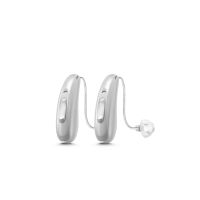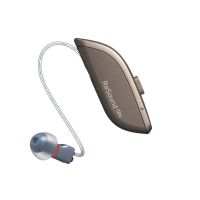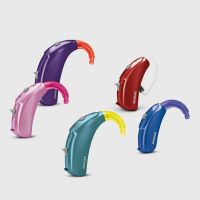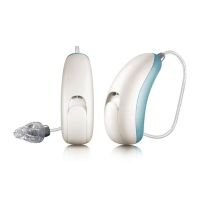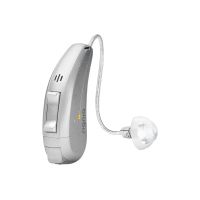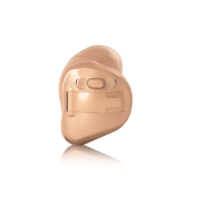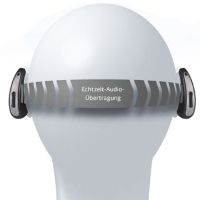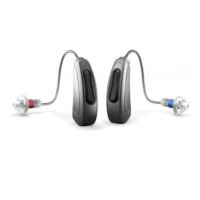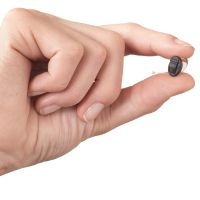Hearing aids
Hearing aids are designed to improve hearing. A distinction is made between two groups:
- Behind-the-ear (BTE) devices are worn behind the pinna. They amplify the sound in the outer ear canals. As the ear canal is open, a natural hearing sensation is created and the ear is well ventilated. In addition, there is usually an interface to telephones or FM systems. These devices are suitable for severe hearing loss.
- In-the-ear (ITE) devices sit completely in the pinna and in the ear canal. They are barely noticeable and pose no problem for people with glasses. They also offer good directional hearing and a natural sound. However, due to the different ear shapes, the devices have to be customized and there is a risk of ear canal blockage. These devices are suitable for mild to moderate hearing loss.
This is just a sample of the hearing aid market. A larger overview can be found in the Statuatory Health Insurance's Medical Technical Aids Register in product group 13.
Today's devices work digitally: the sound picked up by a microphone is converted into a digital signal and amplified. Finally, a loudspeaker transmits the amplified sound to the eardrum via an earmold. Hearing aids require batteries; they are rarely offered with rechargeable batteries.
Adaptations by a hearing aid acoustician play an important role in the provision of hearing aids. They carry out audiological measurements, adjust suitable devices individually to the hearing loss and offer them for testing in everyday life.
know more
Products (48)
-
1 hearing aid – behind-the-ear-hearing-system
Model: Oticon Intent™ miniRITE Manufacturer: Oticon GmbH Distributor: Hörakustik-Fachhandel -
2 headphone – headset
Model: Apple AirPods Pro 2 Manufacturer: Apple Inc. Distributor: Apple Inc. | Fachhandel -
3 personal protective equipment – health protection and work safety – hearing aid with hearing protection – behind-the-ear-hearing-system
Model: Gehörschutz und Hörgerät ICP TIK Manufacturer: Hörluchs Hearing GmbH & Co. KG Distributor: Hörakustik-Fachhandel -
4 personal protective equipment – health protection and work safety – hearing aid with hearing protection – behind-the-ear-hearing-system
Model: AS Hörluchs ICP Hörgeräte Manufacturer: Hörluchs Hearing GmbH & Co. KG Distributor: Hörakustik-Fachhandel -
5 hearing aid – in-the-ear-hearing-system
Model: Evolv AI-Serie Manufacturer: Starkey Laboratories (Germany) GmbH Distributor: Hörakustik-Fachhandel -
6 hearing aid – in-the-ear-hearing-system
Model: Oticon Opn IIC /CIC IdO Manufacturer: Oticon GmbH Distributor: audibene GmbH | Hörakustik-Fachhandel -
7 hearing aid – in-the-ear-hearing-system
Model: Signia Silk X Manufacturer: Signia GmbH Distributor: Hörakustik-Fachhandel -
8 hearing aid – behind-the-ear-hearing-system
Model: Phonak Audéo Fit Manufacturer: Sonova Deutschland GmbH - Geschäftsbereich Phonak Distributor: Hörakustik-Fachhandel -
9 hearing aid – behind-the-ear-hearing-system
Model: Vibrosonic alpha Manufacturer: Vibrosonic GmbH Distributor: Hörakustik-Fachhandel -
10 hearing aid – behind-the-ear-hearing-system
Model: Bernafon Alpha Manufacturer: Bernafon AG -International Headquarter Distributor: Hörakustik-Fachhandel -
11 hearing aid – behind-the-ear-hearing-system
Model: Bernafon Encanta miniRITE Manufacturer: Bernafon AG -International Headquarter Distributor: Hörakustik-Fachhandel -
12 hearing aid – behind-the-ear-hearing-system
Model: Bernafon Viron miniRITE / MNR Manufacturer: Bernafon AG -International Headquarter Distributor: Hörakustik-Fachhandel -
13 hearing aid – behind-the-ear-hearing-system
Model: Oticon Ruby Manufacturer: Oticon GmbH Distributor: Hörakustik-Fachhandel -
14 hearing aid – behind-the-ear-hearing-system
Model: Mood G6 Manufacturer: AS AUDIO-SERVICE GmbH Distributor: Hörakustik-Fachhandel -
15 hearing aid – behind-the-ear-hearing-system
Model: Audéo Paradise P-R Manufacturer: Sonova AG Distributor: Hörakustik-Fachhandel -
16 hearing aid – behind-the-ear-hearing-system
Model: ReSound ONE Manufacturer: GN Hearing GmbH Distributor: Hörakustik-Fachhandel -
17 hearing aid – behind-the-ear-hearing-system
Model: Widex Clear 440 / Widex Clear 440 Fusion Manufacturer: Widex Hörgeräte GmbH Distributor: Hörakustik-Fachhandel -
18 hearing aid – behind-the-ear-hearing-system
Model: ReSound LiNX2 Hörsysteme Manufacturer: GN Hearing GmbH Distributor: Hörakustik-Fachhandel -
19 hearing aid – behind-the-ear-hearing-system
Model: ReSound Up Smart Manufacturer: GN Hearing GmbH Distributor: Hörakustik-Fachhandel -
20 hearing aid – behind-the-ear-hearing-system
Model: Phonak Audéo V Manufacturer: Sonova AG Distributor: Hörakustik-Fachhandel -
21 hearing aid – behind-the-ear-hearing-system
Model: Phonak Bolero V Manufacturer: Sonova AG Distributor: Hörakustik-Fachhandel -
22 hearing aid – behind-the-ear-hearing-system
Model: Phonak Sky Q Manufacturer: Sonova AG Distributor: Hörakustik-Fachhandel -
23 hearing aid – behind-the-ear-hearing-system
Model: Unitron Stride Manufacturer: Sonova Deutschland GmbH - Geschäftsbereich Unitron Distributor: Hörakustik-Fachhandel -
24 hearing aid – behind-the-ear-hearing-system
Model: Unitron Moxi-Serie Manufacturer: Sonova Deutschland GmbH - Geschäftsbereich Unitron Distributor: Hörakustik-Fachhandel -
25 hearing aid – behind-the-ear-hearing-system
Model: Unitron Max-Serie Manufacturer: Sonova Deutschland GmbH - Geschäftsbereich Unitron Distributor: Hörakustik-Fachhandel -
26 hearing aid – behind-the-ear-hearing-system
Model: Widex Dream-Serie Manufacturer: Widex Hörgeräte GmbH Distributor: Hörakustik-Fachhandel -
27 hearing aid – behind-the-ear-hearing-system
Model: Pure S primax Manufacturer: Signia GmbH Distributor: Hörakustik-Fachhandel -
28 hearing aid – behind-the-ear-hearing-system
Model: Phonak Audéo Marvel Manufacturer: Sonova AG Distributor: Hörakustik-Fachhandel -
29 hearing aid – behind-the-ear-hearing-system
Model: Oticon Opn HdO Manufacturer: Oticon GmbH Distributor: Hörakustik-Fachhandel -
30 hearing aid – behind-the-ear-hearing-system
Model: Signia Intuis 3 Manufacturer: Signia GmbH Distributor: Hörakustik-Fachhandel -
31 hearing aid – behind-the-ear-hearing-system
Model: Signia Motion 13 Nx Manufacturer: Signia GmbH Distributor: Hörakustik-Fachhandel -
32 hearing aid – in-the-ear-hearing-system
Model: Audionova T50 Manufacturer: Sonova AG Distributor: Hörakustik-Fachhandel -
33 hearing aid – in-the-ear-hearing-system
Model: Livio Edge AI Manufacturer: Starkey Laboratories (Germany) GmbH Distributor: Hörakustik-Fachhandel -
34 hearing aid – behind-the-ear-hearing-system
Model: via pro P Manufacturer: audifon GmbH & Co. KG Distributor: Hörakustik-Fachhandel -
35 hearing aid – tinnitus therapy apparatus – behind-the-ear-hearing-system
Model: audifon sueno pro R Manufacturer: audifon GmbH & Co. KG Distributor: Hörakustik-Fachhandel -
36 hearing aid – tinnitus therapy apparatus – in-the-ear-hearing-system
Model: audifon sueno pro ITE Manufacturer: audifon GmbH & Co. KG Distributor: Hörakustik-Fachhandel -
37 hearing aid – tinnitus therapy apparatus – behind-the-ear-hearing-system
Model: audifon faro S+ TRT Manufacturer: audifon GmbH & Co. KG Distributor: Hörakustik-Fachhandel -
38 hearing aid – tinnitus therapy apparatus – in-the-ear-hearing-system
Model: audifon faro IS TRT / audifon faro IS+ TRT Manufacturer: audifon GmbH & Co. KG Distributor: Hörakustik-Fachhandel -
39 hearing aid – behind-the-ear-hearing-system
Model: Phonak Audéo Lumity Manufacturer: Sonova AG Distributor: Hörakustik-Fachhandel -
40 hearing aid – in-the-ear-hearing-system
Model: Icon G5 Manufacturer: AS AUDIO-SERVICE GmbH Distributor: Hörakustik-Fachhandel -
41 hearing aid – in-the-ear-hearing-system
Model: Ida BT G5 Manufacturer: AS AUDIO-SERVICE GmbH Distributor: Hörakustik-Fachhandel -
42 hearing aid – in-the-ear-hearing-system
Model: Bernafon IO-Modell Juna 9 Manufacturer: Bernafon Hörgeräte GmbH Distributor: Hörakustik-Fachhandel | HÖREX Hör-Akustik eG -
43 hearing aid – in-the-ear-hearing-system
Model: KIND Standard-IdO-Hörgerät Manufacturer: KIND Hörgeräte GmbH & Co. KG Distributor: Hörakustik-Fachhandel -
44 hearing aid – in-the-ear-hearing-system
Model: Phonak Lyric Manufacturer: Sonova AG Distributor: Hörakustik-Fachhandel -
45 hearing aid – in-the-ear-hearing-system
Model: Phonak Tao Q Manufacturer: Sonova AG Distributor: Hörakustik-Fachhandel -
46 hearing aid – in-the-ear-hearing-system
Model: Phonak Virto Marvel M-312 Manufacturer: Sonova AG Distributor: Hörakustik-Fachhandel -
47 hearing aid – behind-the-ear-hearing-system
Model: KIND Standard Hinter-dem Ohr-Hörgerät Manufacturer: KIND Hörgeräte GmbH & Co. KG Distributor: Hörakustik-Fachhandel -
48 hearing aid – behind-the-ear-hearing-system
Model: Signia Pure Charge&Go IX Manufacturer: Signia GmbH Distributor: Hörakustik-Fachhandel


